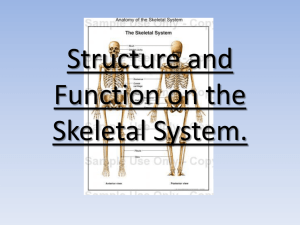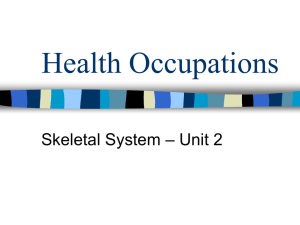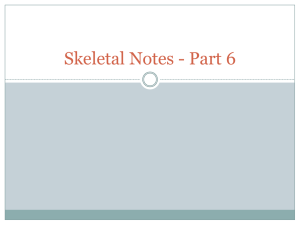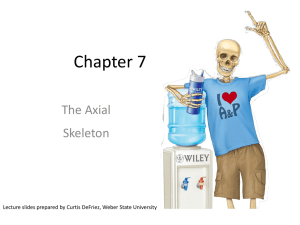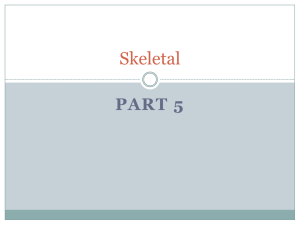Structure of the skeletal system
advertisement
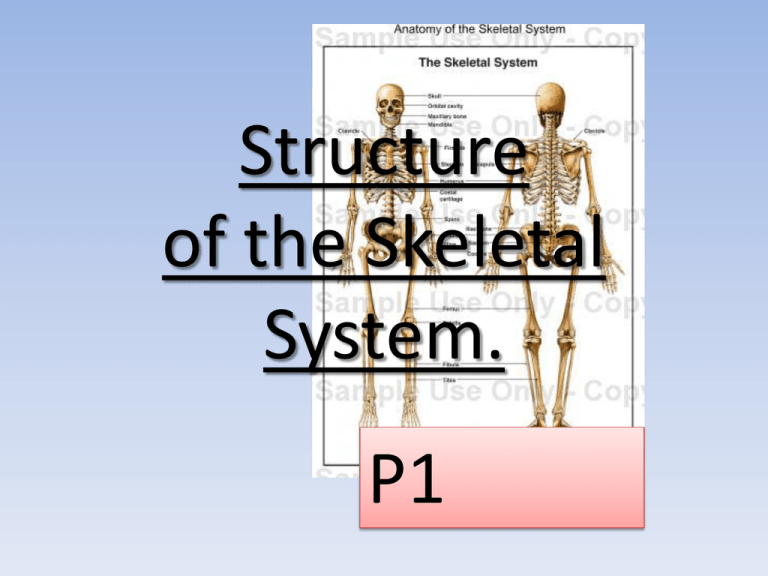
Structure of the Skeletal System. P1 Structure of the Skeleton We know that the 206 bones of the skeleton are split into two different groups… The Axial Skeleton – 80 bones Appendicular skeleton – 126 bones The Consists of: Skull The vertebrae The central core of the body or its AXIS. The sternum The ribs It provides the core from which the limbs hang from. The parts/ limbs hanging off of the AXIAL skeleton. Shoulder Girdle (scapula/ clavicle) Pelvic Girdle Upper and Lower limbs Task… List the below Bone names into the relevant column in the table below… Location of major bones: • Cranium • Clavicle • Ribs • Sternum • Humerus • Radius • Ulna • Scapula • Ilium • Pubis • Ischium • Carpals & Metacarpals & Phalanges • Femur • Patella • Tibia • Fibula • Tarsals & Metatarsals • Vertebral column – (cervical, thoracic, and lumbar vertebrae, sacrum, coccyx) Axial Skeleton Answers!! Appendicular Skeleton Task: Match the EVERY DAY name for each bone, with its correct ANATOMICAL name. Every day Name Skull Collar Bone Breast Bone Ribs Spine Shoulder Blade Arm Forearm Forearm Pelvis Thigh Bone Anatomical Name Ribs Illium Pubis Ischium Shin bone Shin bone Knee Cap Wrist Hand Fingers Ankle In pairs: 1 person labels the other as a ‘human skeleton’. Making labels for ALL of the various bones that we have learned thus far. You also need to be to know ‘both’ names for each bone. Task!! Major bones of the body explained… Consists of 8 bones fused together to PROTECT your brain. 14 other facial bones that form the face and jaw… PROTECTS the heart and acts as an ATTACHMENT point for the ribs and clavicle Flat bone in the middle of your chest shaped like a dagger. Adults have 12 pairs of ribs, that run between sternum and thoracic vertebrae. True Ribs False Ribs Ribs are flat bones that form a PROTECTIVE cage around the HEART and LUNGS. Floating Ribs One end is connected to the sternum and the other to the scapula The role of the Clavicle is to keep the scapula the correct distance from the sternum Provides a point of attachment for many muscles of upper arm and back. Situated on the upper back of the body The Humerus, Radius and Ulna all form the ELBOW joint. In order for the hand to move, the Radius moves across the ulna… Ulna Radius Humerus Consists of 3 area, made up of different kind of bone. Phalanges - 14 bones Meta-Carpels Carpels- 8 bones Consists of 3 bones fused togetherILLIUM, PUBIS and ISCHIUM Function: to PROTECT the lower internal organs… such as the bladder, reproductive organs and when pregnant the developing foetus! Femur: Longest Consists of 4 bones: FEMUR, FIBULA, TIBIA and PATELLA bone in the body and forms the knee joint with the TIBIA Patella: Bone that floats over the knee and lie within the patella tendon and SMOOTHES the movement of the tendons over the knee. Tibia: The weight bearing bone of the lower leg Fibula: The non-weight bearing bone of the lower leg and helps form the ankle. Tarsals- 7 bones -5 Bones Consists of 3 areas: Tarsals, Metatarsals and Phalanges 3 Phalanges in each toe… apart from the big toe that has 2 7 Cervical vertebrae make up the neck and runs to the shoulders 12 Thoracic vertebrae make up the chest area 5 Lumbar vertebrae make up the lower back 5 vertebrae which are fixed together make the Sacrum. Coccyx is 4 bones fused together, remnants from when we had a tail! Long Bone Femur Humerus Tibia Metacarpals Phalanges Having a body longer than it is wide and having growth plates at either end (epiphysis) Flat Bones Flat bones are strong, flat plates of bone with the main function of providing protection to the bodies vital organs and being a base for muscular attachment. Scapula (shoulder blade). The Sternum (breast bone), Cranium (skull), Pelvis and Ribs are also classified as flat bones Function of Protection and Stability, with little movement Short Bone They are approximately wide as they are long Irregular Bones These are bones that do not fit into any other category due to their unusual shape. Good examples being the Vertebrae, Sacrum and Mandible (lower jaw). The most obvious example: The Patella (knee cap) which sits within the Patella or Quadriceps tendon. Sesamoid Bones Sesamoid bones are usually present in a tendon where it passes over a joint, acting as protection to the tendon. Sesamoid bones are usually short or irregular bones, imbedded in a tendon. 1) Learners must describe the axial and appendicular skeleton. different types of bone in each of the skeletons and be able to locate all of the named bones 2) The stated in the Unit content (List). 3) They must also describe the of the skeletal system. function Functions: • Support • Protection • Attachment for skeletal muscle • Source of blood cell production • Store of minerals Types of bone: Long bones, Short bones, Flat bones, Irregular bones, Sesamoid bones Location of major bones: • • • • • • • • • • • • • • • • • • Cranium Clavicle Ribs Sternum Humerus Radius Ulna Scapula Ilium Pubis Ischium Carpals & Metacarpals & Phalanges Femur Patella Tibia Fibula Tarsals & Metatarsals Vertebral column – (cervical, thoracic, and lumbar vertebrae, sacrum, coccyx)
